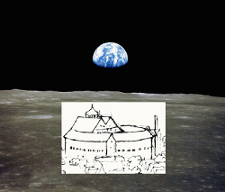The Woman in the Dunes. Kobo Abe.
The Shifting Sands of Modernity…. June 24, 2000
Shortly after the Meiji Restoration of 1868 narrative writing became heavily influenced by Western literature. Although there are many excellent early fiction writers and those who, like Junichiro Tanizaki and Yasunari Kawabata, tend to reflect more traditional aesthetics, or those of the “I-novel,” Kobo Abe (1924-1993), a Marxist, is the first significantly modern Japanese novelist. His childhood in Manchuria helped him to look harder and more objectively than other writers at modern Japanese life, particularly in Tokyo, where Abe lived the rest of his life, while his growing up in Manchuria surely added to the sense of alienation that pervades his work. His early stories following World War II already express a profoundly existentialist angst and absurdity that has often led to his being compared to Kafka, Camus, Sartre, or Samuel Beckett. To my mind, though, it is precisely the fact that Abe is Japanese that is important and to view him as a mere imitator of the West would be a mistake. Rather than casting his experience into Kafkaesque terms, he is responding to his own experience of modern Japanese life. I believe Westerners need to think deeply about what that means for modern Japan, especially those dreamy Westerners who romantically idealize the traditional image of medieval Japan, as though it still exists.
In the short story “Magic Chalk” (1950), Abe tells the tale of “a poor artist named Argon.” Flat broke and starving, Argon discovers in his shabby apartment a piece of red chalk with which he mindlessly draws pictures of food and dishes on the wall. Falling asleep, he groans, “I’ve got to eat!” Suddenly, he is awakened by the sound of food and crockery crashing to the floor: “The pictures he had chalked on the wall had vanished.” Seeing food all around, he eats his fill and reflects, “the laws of the universe have changed.” He then draws a bed, since he lacks one, as well as other furniture and food. The realization hits him that he can create an entirely new world and spends four weeks contemplating just how to do it. Driven to despair by the burdensome responsibility, he finally decides merely to draw a door to the new world, but upon opening it finds, “an awesome wasteland glaring in the noonday sun.” He would have “to draw the world all over again” and begins with Eve, “stark naked,” to whom he identifies himself as Adam and “also an artist, and a world planner.” Eve, however, borrows his chalk, draws a gun, and shoots him. Other people in the building hear the gunshot: “By the time they ran in, Argon had been completely absorbed into the wall and had become a picture”:
“After everyone left, there came a murmuring from the wall. ’it isn’t chalk that will remake the world . . .’ A single drop welled out of the wall. It fell from just below the eye of the pictorial Argon.” (tr. Alison Kibrick)
Writing shortly after World War II, Abe understands modern Japan has lost something of immense value, and a mere artist can not replace it.
In Kobo Abe’s masterpiece The Woman in the Dune (1962), the protagonist Niki Jumpei, an amateur entomologist, travels to the seaside to collect specimens. He happens on a village built in the midst of the dunes with houses at the bottom of huge craters or cavities of sand. Peering down into one of the cavities at a small house “submerged in silence,” he muses, “no matter what they did . . . there was no escaping the law of the sand.” This “law” soon becomes clear when village men trick him into going sixty feet down in a cavity to spend the night at an old woman’s house. Before long, he realizes that there is probably no way to get back out. The “ceaselessly flowing sand,” “this shapeless, destructive power,” which “had no form” of its own, was continually pouring down on the little house threatening to destroy it and bury its occupants alive. Every night the woman shovels sand into baskets which the village men haul up by rope and carry away, just enough to prevent their suffocation. Watching her, Niki Jumpei remarks, “you’ll never finish, no matter how long you work at it.” Later, the narrator explains, “the only certain factor was its movement; sand was the antithesis of all form.” Despite his many appeals for help from the village men, the village benefits from the sand being fought back and they refuse to permit him to leave.
The men, however, are careful to provide the woman and man with the necessities of life as long as they continue to perform the nightly work of clearing back the everdrifting sand of reality, for the sand is manifestly symbolic. Upon his request, they even give Jumpei a newspaper. Reading the usual headlines of political, business, and domestic crimes and intrigues, Jumpei thinks,
“There wasn’t a single item of importance. A tower of illusion, all of it, made of illusory bricks and full of holes. . . . And so everybody, knowing the meaninglessness of existence, sets the center of his compass at his own home.”
This “illusion” is not the illusion of Buddhism, the floating world of Genji symbolizing a world of spiritual import. It is the illusion of everyday life through which the nihilist sees “the meaningless of existence,” at last confronted, the real truth of human experience. “The world,” Abe has Jumpei say in a simile, “is like sand.” Modern Japanese writers have found the transition easy to make from the illusion of samsara to the illusion of nihilism which is quotidian reality. Similarly, the old woman turns out not to be so old after all, and Jumpei learns social customs are merely illusions too, as he rapes her brutally and repeatedly while she at times enjoys or submits to it. When the opportunity for escape finally comes, drained of all inner meaning, strength, and purpose, he no longer has the will to leave.
In the story “Beyond the Curve” (1966), Abe writes about a man who, while climbing up a hill, comes to a halt before a curve in the road:
“For the life of me, I couldn’t visualize what lay beyond the curve. . . . I knew perfectly well that beyond the curve was the town on the hilltop where I lived. My temporary lapse of memory in no way altered the fact of its existence.”
He stands there agonizing in his mind about what might or ought to be around the curve until he is overcome by anxiety, fearing “the town’s very existence would fade away and then vanish.” He considers, “I myself was no longer myself, but some mysterious other.” Nausea overtakes him. He manages to turn around and walk back down the hill. His “old confidence was gone.” Taking refuge in a coffee shop, he wonders, no longer sure, who he is since he has forgotten his name and where he works. Frantically fumbling with the contents of his wallet and pockets, looking for clues, he realizes, “I had mislaid . . . myself.” Abe expresses here not only the universally modern sense of existential void but especially the Japanese fear of the loss of traditional identity under the onslaught of modernity. Abe’s persona significantly and desperately says, “Until I found that town beyond the curve, there could be no resolution.” And so it is for modern Japan. He takes a taxi up the hill, beyond the curve:
“Spatially, the town had a solid physical existence, but temporally, it was a vacuum. It existed–yet horribly, it had no existence whatever . . . the town I knew was gone.”
Though seeking answers from others, he “alone was lost, uncomprehending.” Physically, materially, like the West, Japan exists; in terms of social or psychological time, the “vacuum,” quintessentially the same as in the West, has swallowed everything: “The town I knew was gone.” What lies beyond the curve, if anything, remains to be seen.





